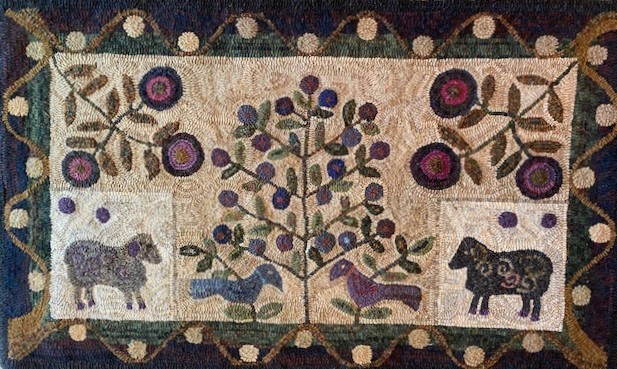Pictured Above: New England Berry Tree, hooked by Libbey Lundgren, designed by Barbara Carroll
Among the many textile arts that settlers brought with them to Nebraska, traditional rug hooking is not as well-known as weaving or embroidery to those outside of the textile arts. For visitors to the West Nebraska Arts Center in March 2021, their first experience with traditional rug hooking was an exhibition developed in collaboration with The-Hole-in-the-Wall Traditional Rug Hookers. Eighteen artists were featured in the exhibition, the youngest being 12 years old. According to Libbey Lundgren, founder of The-Hole-in-the-Wall Traditional Rug Hookers, rug hooking is defined by its methods and materials, rather than any single style, which means artists are free to develop a style all their own. This helps explain the variety of styles and subjects on display at WNAC.
Although current traditional rug hookers use traditional techniques, they incorporate contemporary imagery, personal preferences for color or style and their own experiences. Cloth strips of different colors, widths, and patterns are used to create textures and imagery. Wool fabric is the primary material, which is pulled up in loops through a backing made of linen, monk’s cloth, or rug warp. Early settlers used old clothes and blankets to create rugs that were both practical and beautiful or as Lundgren states, “They made something warm for the home and something warm for the heart.” Rug hooking, like so many folk and traditional arts that are rooted in community and history, reflect the artist’s commitment to tradition and their own experience and voice as an artist.
Thankfully, there are a wide range of online resources, patterns, as well as a number of local, regional, and international groups to help grow the number of traditional rug hookers. Organizations like the Midwest Rug Hookers, the Association of Traditional Hooking Artists, and the International Guild of Handhooking Rugmakers provide artists with tips and information about their artform. Some rug hooking organizations hold annual “hook-ins” where artists share ideas, learn from mentors, and showcase their own unique rugs. More important than the large national and international organizations are rug hooking guilds found in almost every state and community rug hooking groups that offer invaluable educational opportunities for rug hookers, hold monthly meetings and foster a strong sense of community and artistry.

